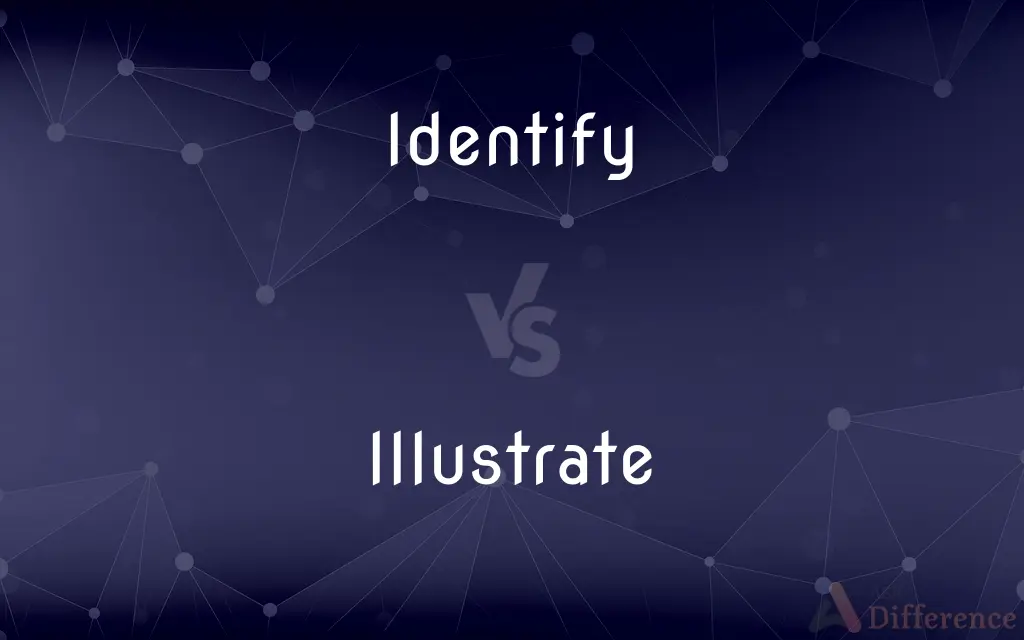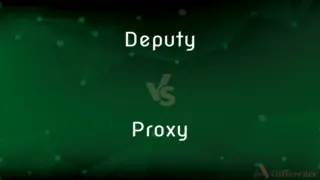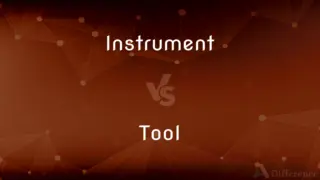Identify vs. Illustrate — What's the Difference?
By Tayyaba Rehman & Maham Liaqat — Updated on March 18, 2024
Identify involves recognizing and naming something or someone, focusing on distinguishing characteristics, while illustrate means to explain or make something clear by using examples, pictures, or diagrams.

Difference Between Identify and Illustrate
Table of Contents
ADVERTISEMENT
Key Differences
Identify is the process of recognizing or distinguishing something or someone by its or their defining features. This involves pinpointing specific characteristics that set the subject apart from others, often used in contexts like biology to identify species, or in security to identify individuals. On the other hand, illustrate is used to clarify or explain concepts, ideas, or processes by providing visual representations or examples. It emphasizes making information more accessible or understandable, often involving imagery, diagrams, or descriptive examples to convey complex information in a simpler form.
Identification is crucial in various fields, from scientific research, where species or elements are identified based on specific traits, to law enforcement, where individuals are identified through fingerprints or facial recognition. The emphasis is on accuracy and specificity, using unique identifiers to precisely pinpoint or categorize subjects. Whereas, illustrating is a method used across educational, scientific, and communicative contexts to enhance understanding or retention of information, relying on visual or contextual aids to bridge gaps in knowledge or comprehension.
The act of identifying often requires a base of knowledge or criteria for comparison, such as identifying a bird species by its coloration or song, or identifying a problem in a system by its symptoms. This process is analytical and deductive, focused on distinguishing one thing from another based on set characteristics. In contrast, illustrating involves the creative or strategic use of examples, metaphors, or visuals to explain or highlight aspects of the subject matter, making abstract or complex ideas more tangible and relatable to the audience.
In educational settings, identification skills enable students to distinguish between similar concepts or items, a critical aspect of learning and comprehension. For instance, identifying different mathematical functions based on their formulas or graphs. Illustrating, however, enhances teaching methods by providing concrete examples or visual aids that simplify complex ideas, like using a graph to illustrate economic trends, aiding in deeper understanding and engagement.
Both identifying and illustrating are complementary processes in the acquisition and dissemination of knowledge. While identification focuses on recognition and differentiation, making sense of the world by categorizing and labeling, illustrating aims to deepen understanding and connection with the subject matter, making information more accessible and memorable through visualization or example.
ADVERTISEMENT
Comparison Chart
Definition
To recognize or determine something/someone by distinguishing features.
To make something clear by using examples, pictures, or diagrams.
Focus
Recognition and differentiation.
Explanation and clarification.
Process
Analytical, based on specific characteristics or criteria.
Creative or strategic, using visual or contextual aids.
Usage Context
Biology (species identification), security (individual recognition).
Education (teaching), communication (enhancing understanding).
Objective
To pinpoint or categorize based on unique identifiers.
To convey complex information in an accessible form.
Compare with Definitions
Identify
To recognize or name someone or something from known characteristics.
She can identify a song just by hearing a few notes.
Illustrate
To use figures of speech, like metaphors or similes, to clarify or enhance descriptions.
She illustrated her point about the economy with a ship navigating through stormy seas.
Identify
To associate closely with; to consider oneself a part of a group.
He identifies strongly with his cultural heritage.
Illustrate
To serve as an example of.
His career illustrates the importance of hard work and determination.
Identify
To diagnose or detect a particular problem or disease.
The mechanic identified the issue with the car as a faulty alternator.
Illustrate
To make clear or vivid; to illuminate.
The documentary illustrated the challenges of life in extreme environments.
Identify
To establish the identity of someone or something.
The detective worked to identify the suspect in the lineup.
Illustrate
To explain or make something clear by using examples.
The teacher illustrated the concept of gravity with an apple falling from a tree.
Identify
To find or point out an object or fact of interest.
The guide identified several constellations in the night sky.
Illustrate
To adorn or accompany with drawings, pictures, or other artwork.
The children's book was illustrated with colorful drawings.
Identify
To establish or recognize the identity of; ascertain as a certain person or thing
Can you identify what kind of plane that is? I identified the man at the next table as a famous actor.
Illustrate
Provide (a book, newspaper, etc.) with pictures
The guide is illustrated with full-colour photographs
Identify
(Biology) To determine the taxonomic classification of (an organism).
Illustrate
Serve as an example of
The World Cup illustrated what high standards our players must achieve
Identify
To ascertain as having a certain characteristic or feature
Job candidates who are identified as overqualified.
Children who have been identified with hearing loss.
Illustrate
To clarify or explain, as by the use of examples or comparisons
The mayor illustrated the problem with an anecdote.
Identify
To consider as identical or united; equate
The Greek god Ares is identified with the Roman god Mars.
Illustrate
To serve as an example or clarification of
A story that illustrates a broader social problem.
Identify
To associate or affiliate closely with
Writers who are identified with modernism.
Illustrate
To provide (a text) with explanatory or decorative images
Illustrated the book with colorful drawings.
Identify
To consider oneself as sharing certain characteristics or attitudes as another
She identifies strongly with her grandmother.
Illustrate
(Obsolete) To light up; illuminate.
Identify
To associate oneself with or admire something, such as a set of ideas
A language learner who identifies with a new culture.
Illustrate
To present a clarification, example, or explanation.
Identify
(transitive) To establish the identity of someone or something.
It was hard to identify the shoplifter because the CCTV records didn't have a clear image.
Illustrate
(obsolete) To shed light upon.
Identify
(transitive) To disclose the identity of someone.
The Associated Press will not identify the suspect of the crime because he is a juvenile.
Illustrate
(figurative) To clarify something by giving, or serving as, an example or a comparison.
We illustrate our definitions by including quotations or simple examples.
Identify
To establish the taxonomic classification of an organism.
Illustrate
To provide a book or other publication with pictures, diagrams or other explanatory or decorative features.
The economics textbook was illustrated with many graphs.
Identify
(transitive) To equate or make the same; to unite or combine into one.
Illustrate
(obsolete) To give renown or honour to; to make illustrious.
Identify
(reflexive) To have a strong affinity with; to feel oneself to be modelled on or connected to.
Illustrate
To make clear, bright, or luminous.
Here, when the moon illustrates all the sky.
Identify
(intransitive) To associate oneself with some group; to feel, or believe one feels, the same way.
Illustrate
To set in a clear light; to exhibit distinctly or conspicuously.
To prove him, and illustrate his high worth.
Identify
To claim an identity; to describe oneself as a member of a group; to assert the use of a particular term to describe oneself.
Illustrate
To make clear, intelligible, or apprehensible; to elucidate, explain, or exemplify, as by means of figures, comparisons, and examples.
Identify
To make to be the same; to unite or combine in such a manner as to make one; to treat as being one or having the same purpose or effect; to consider as the same in any relation.
Every precaution is taken to identify the interests of the people and of the rulers.
Let us identify, let us incorporate ourselves with the people.
Illustrate
To adorn with pictures, as a book or a subject; to elucidate with pictures, as a history or a romance.
Identify
To establish the identity of; to prove to be the same with something described, claimed, or asserted; as, to identify stolen property.
Illustrate
To give renown or honor to; to make illustrious; to glorify.
Matter to me of glory, whom their hateIllustrates.
Identify
To become the same; to coalesce in interest, purpose, use, effect, etc.
Illustrate
Illustrated; distinguished; illustrious.
This most gallant, illustrate, and learned gentleman.
Identify
Recognize as being; establish the identity of someone or something;
She identified the man on the 'wanted' poster
Illustrate
Clarify by giving an example of
Identify
Give the name or identifying characteristics of; refer to by name or some other identifying characteristic property;
Many senators were named in connection with the scandal
The almanac identifies the auspicious months
Illustrate
Depict with an illustration
Identify
Consider (oneself) as similar to somebody else;
He identified with the refugees
Illustrate
E.g., illustrate a book with drawings
Identify
Identify as in botany or biology, for example
Identify
Consider to be equal or the same;
He identified his brother as one of the fugitives
Common Curiosities
What is the primary goal of identifying something?
The primary goal is to recognize and name something or someone by distinguishing features.
Can identify and illustrate be used together?
Yes, identification can determine what something is, while illustration can help explain or clarify it further.
How does illustrating help in education?
It helps by making concepts clear through examples, pictures, or diagrams, enhancing understanding and retention.
Is identifying always related to visual characteristics?
No, it can also involve other senses or criteria, such as sound for identifying bird calls, or patterns for identifying trends.
What skills are necessary for effective identification?
Observation, knowledge of distinguishing features, and analytical thinking are key skills.
What makes a good illustration?
A good illustration effectively clarifies or explains a concept, making it accessible and engaging through relevant examples or visuals.
Can illustrations be misleading?
Yes, if inaccurately represented or overly simplified, illustrations can mislead or confuse the intended message.
Why is illustrating considered a creative process?
It involves creating or choosing visuals or examples that effectively communicate complex information in an understandable way.
How important is context in identification?
Context is crucial as it provides the necessary background or criteria for accurate identification.
How can identifying be applied in everyday life?
It can be used for tasks like recognizing people, diagnosing problems with technology, or identifying plants and animals.
In what ways can illustrating aid in communication?
Illustrating can bridge language barriers, clarify complex ideas, and make messages more memorable or engaging.
Is there a digital aspect to illustrating?
Yes, digital tools and software can enhance illustrating, allowing for complex visualizations and interactive examples.
How do cultural differences affect identification?
Cultural backgrounds can influence what characteristics are considered distinguishing or how objects and people are categorized.
How do identify and illustrate contribute to problem-solving?
Identification helps diagnose or recognize the problem, while illustration can be used to explain possible solutions or outcomes.
Can illustrating be applied in non-visual contexts?
Yes, through descriptive language, metaphors, or examples that make abstract concepts more tangible.
Share Your Discovery

Previous Comparison
Deputy vs. Proxy
Next Comparison
Instrument vs. ToolAuthor Spotlight
Written by
Tayyaba RehmanTayyaba Rehman is a distinguished writer, currently serving as a primary contributor to askdifference.com. As a researcher in semantics and etymology, Tayyaba's passion for the complexity of languages and their distinctions has found a perfect home on the platform. Tayyaba delves into the intricacies of language, distinguishing between commonly confused words and phrases, thereby providing clarity for readers worldwide.
Co-written by
Maham Liaqat













































